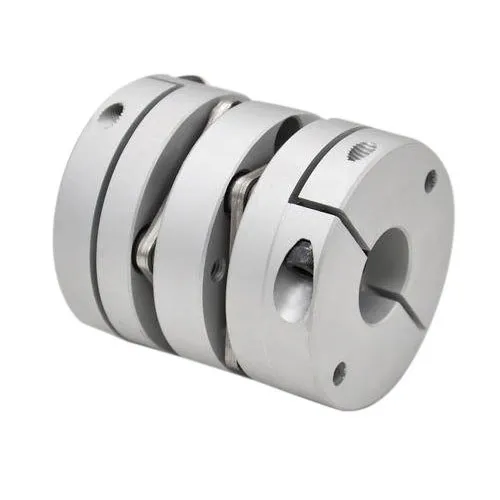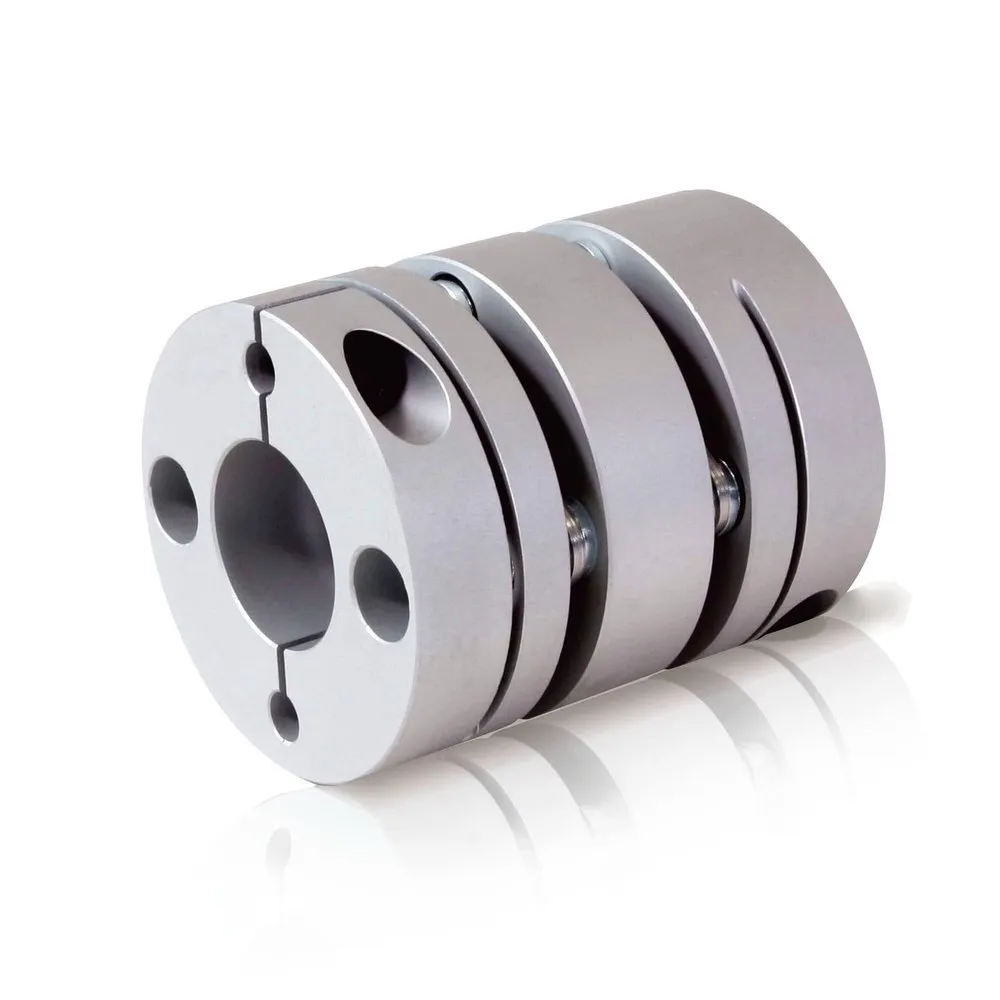Product Description
| Item No. | φD | L | W | L1 | M | Tighten the strength(N.m) |
| SG7-8-C19- | 19.5 | 20 | 1.2 | 9.4 | M2.5 | 1 |
| SG7-8-C26- | 26 | 25.5 | 2.5 | 11.5 | M3 | 1.5 |
| SG7-8-C34- | 34 | 32.3 | 3.3 | 14.5 | M4 | 1.5 |
| SG7-8-C39- | 39 | 34.1 | 4.1 | 15 | M4 | 2.5 |
| SG7-8-C44- | 44 | 34.5 | 4.5 | 15 | M4 | 2.5 |
| SG7-8-C50- | 50 | 40.5 | 4.5 | 18 | M5 | 7 |
| SG7-8-C56- | 56 | 45 | 5 | 20 | M5 | 7 |
| SG7-8-C68- | 68 | 54 | 6 | 24 | M6 | 12 |
| SG7-8-C82- | 82 | 68 | 8 | 30 | M8 | 16 |
| SG7-8-C94- | 94 | 68 | 8 | 30 | M8 | 28 |
| SG7-8-C104- | 104 | 70 | 10 | 30 | M8 | 28 |
| Item No. | Rated torque | Maximum Torque | Max Speed | Inertia Moment | N.m rad | RRO | Tilting Tolerance | End-play | Weight:(g) |
| SG7-8-C19- | 1N.m | 2N.m | 10000prm | 0.65×10-6kg.m² | 200N.m/rad | 0.04mm | 1c | ±0.2mm | 12 |
| SG7-8-C26- | 1.4N.m | 2.8N.m | 10000prm | 1.8×10-6kg.m² | 690N.m/rad | 0.04mm | 1c | ±0.2mm | 31 |
| SG7-8-C34- | 2.8N.m | 5.6N.m | 10000prm | 7.2×10-6kg.m² | 1650N.m/rad | 0.04mm | 1c | ±0.2mm | 64 |
| SG7-8-C39- | 5.8N.m | 11.6N.m | 10000prm | 1.8×10-5kg.m² | 2500N.m/rad | 0.04mm | 1c | ±0.2mm | 97 |
| SG7-8-C44- | 8.7N.m | 17.4N.m | 10000prm | 2.5×10-5kg.m² | 2900N.m/rad | 0.04mm | 1c | ±0.2mm | 113 |
| SG7-8-C50- | 15N.m | 30N.m | 10000prm | 8.2×10-5kg.m² | 6700N.m/rad | 0.04mm | 1c | ±0.2mm | 195 |
| SG7-8-C56- | 25N.m | 50N.m | 10000prm | 1×10-4kg.m² | 8400N.m/rad | 0.04mm | 1c | ±0.2mm | 263 |
| SG7-8-C68- | 55N.m | 110N.m | 10000prm | 1.9×10-4kg.m² | 11500N.m/rad | 0.04mm | 1c | ±0.2mm | 445 |
| SG7-8-C82- | 80N.m | 160N.m | 10000prm | 7×10-4kg.m² | 14550N.m/rad | 0.04mm | 1c | ±0.2mm | 892 |
| SG7-8-C94- | 185N.m | 370N.m | 10000prm | 1.23×10-3kg.m² | 16900N.m/rad | 0.04mm | 1c | ±0.2mm | 950 |
| SG7-8-C104- | 255N.m | 510N.m | 10000prm | 1.86×10-3kg.m² | 25100N.m/rad | 0.04mm | 1c | ±0.2mm | 1190 |
/* March 10, 2571 17:59:20 */!function(){function s(e,r){var a,o={};try{e&&e.split(“,”).forEach(function(e,t){e&&(a=e.match(/(.*?):(.*)$/))&&1

Thermal Considerations and Limits for Continuous Operations with Servo Couplings
Servo couplings, like many mechanical components, can experience temperature changes during continuous operation. It is essential to consider thermal factors and establish temperature limits to ensure the proper functioning and longevity of the couplings. Here are the key thermal considerations and limits:
- Temperature Ratings:
Manufacturers provide temperature ratings for servo couplings, indicating the range of temperatures in which the couplings can operate safely. It is crucial to stay within these specified temperature limits to prevent potential damage to the coupling or its connected components.
- Heat Dissipation:
Servo couplings may generate heat during operation due to friction and torsional loads. The ability of the coupling to dissipate heat effectively helps prevent excessive temperature rise. Choosing a coupling with suitable materials and design can improve heat dissipation.
- Continuous vs. Intermittent Operation:
Servo couplings may have different thermal limits for continuous operation compared to intermittent or start-stop operations. It is essential to ensure that the coupling’s temperature ratings are suitable for the application’s specific mode of operation.
- Environment:
The operating environment can also impact the thermal performance of the servo coupling. High ambient temperatures, confined spaces, or inadequate ventilation can elevate the temperature around the coupling, potentially pushing it beyond its limits.
- Lubrication:
Proper lubrication of the coupling’s components can help reduce friction and heat generation. Using the right lubricant and ensuring regular maintenance can contribute to the coupling’s optimal thermal performance.
- Thermal Expansion:
Thermal expansion of materials can lead to dimensional changes in the coupling. If not accounted for, this expansion can cause misalignment or interference with other components. Understanding the thermal expansion properties of the coupling materials is crucial for precise system design.
- Overheating Prevention:
To prevent overheating, monitoring the coupling’s temperature during continuous operations is advisable. Implementing temperature sensors or thermal monitoring systems can help detect abnormal temperature increases and trigger appropriate actions, such as reducing operating speeds or shutting down the system temporarily.
- Material Selection:
Choosing materials with appropriate thermal properties is vital for withstanding continuous operations. Some materials are more resistant to high temperatures and thermal cycling, making them suitable for applications with demanding thermal conditions.
By considering these thermal considerations and adhering to the specified temperature limits, users can ensure that servo couplings operate reliably and efficiently during continuous operations, avoiding potential failures and ensuring the longevity of the motion control system.

Real-World Examples of Successful Servo Coupling Installations
There are numerous real-world examples where servo couplings have played a vital role in improving performance and reliability in various industrial applications. Here are some successful servo coupling installations:
- Robotics and Automation: In robotic arms and automated manufacturing systems, servo couplings are used to connect the motor to the joint or the end-effector. They provide precise motion control, allowing robots to perform intricate tasks with accuracy and speed.
- CNC Machining: CNC machines use servo couplings to connect the motor to the lead screw or ball screw, translating rotary motion into linear motion. This ensures high precision and repeatability in machining operations.
- Printing and Packaging: Servo couplings are employed in printing presses and packaging machines to drive rollers, feeders, and other components. They enable smooth and synchronized movement, leading to efficient printing and packaging processes.
- Medical Devices: Servo couplings are utilized in medical devices such as surgical robots, imaging systems, and prosthetic devices. They contribute to precise and controlled movements, enhancing the accuracy of medical procedures and diagnostics.
- Textile Machinery: Textile manufacturing equipment, such as weaving and knitting machines, employ servo couplings to control the movement of spindles, rollers, and fabric feed systems. This ensures consistent and uniform fabric production.
- Aerospace Applications: In aircraft and satellite systems, servo couplings are used in control surfaces, antenna positioning systems, and thrust vector control mechanisms. They help achieve precise movements and responsiveness in aerospace operations.
- Semiconductor Manufacturing: Servo couplings are essential in semiconductor manufacturing equipment for wafer handling, precision alignment, and robotic handling of delicate components.
- Renewable Energy: Wind turbines and solar tracking systems use servo couplings to adjust the blade pitch or solar panel angle for maximum energy efficiency in changing wind and sunlight conditions.
These examples demonstrate the widespread application of servo couplings across diverse industries, where their flexibility, precision, and reliability have proven crucial for successful operations.

How to Choose the Right Servo Coupling for Specific Motion Control Applications
Choosing the right servo coupling is crucial for achieving optimal performance and reliability in motion control applications. Here are the key steps to help you select the most suitable servo coupling for your specific application:
- Identify Application Requirements: Start by understanding the specific requirements of your motion control application. Consider factors such as torque and speed requirements, misalignment compensation needed, environmental conditions, and the level of precision and repeatability required.
- Consider Torque Capacity: Determine the maximum torque that the servo coupling needs to transmit. Choose a coupling with a torque capacity that exceeds the peak torque in your application to ensure safety and prevent premature failure.
- Evaluate Misalignment Compensation: Assess the type and amount of misalignment that may occur between the servo motor and the driven load. Different coupling types offer varying degrees of misalignment compensation, such as angular, axial, and parallel misalignment. Select a coupling that can accommodate the expected misalignments to prevent excessive loads on the motor and bearings.
- Examine Speed and Precision: Consider the speed at which the application will operate and the required level of precision. High-speed applications may require couplings with low inertia and high torsional stiffness to minimize vibration and ensure accurate motion control.
- Review Backlash and Torsional Stiffness: Backlash can impact motion accuracy, especially in reversing applications. Look for couplings with low backlash to maintain precise bidirectional control. Additionally, evaluate the torsional stiffness of the coupling to ensure efficient power transmission and response.
- Check Environmental Compatibility: Consider the operating environment, including temperature, humidity, and exposure to chemicals or contaminants. Choose a servo coupling made from materials that can withstand the specific environmental conditions without compromising performance or lifespan.
- Assess Installation and Maintenance: Evaluate the ease of installation and any maintenance requirements of the coupling. Some couplings may require periodic lubrication or replacement of elastomeric elements. Opt for a coupling that is easy to install and maintain to minimize downtime and servicing costs.
- Seek Expert Advice: If you are unsure about the best servo coupling for your application, consult with experts or engineers experienced in motion control systems. They can provide valuable insights and recommend suitable couplings based on your specific needs.
By carefully considering these factors and following the steps outlined above, you can choose the right servo coupling that matches your motion control application’s requirements. A well-chosen coupling will ensure smooth and accurate motion, improve system performance, and extend the lifespan of your servo motor and driven load.


editor by CX 2024-02-12
